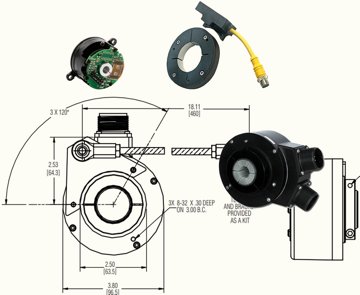What Should I Consider When Converting DC Tachometers to Encoders?
Posted by London Rhodes on Jul 29, 2021 10:27:16 AM
Topics: Installation, Troubleshooting
What Are Critical Aspects to Specifying Resolvers?
Posted by London Rhodes on Jul 29, 2021 10:24:03 AM
The five most important factors to consider when specifying the proper resolver for your application include: input voltage, input current, transformation ration, size of resolver, speed of resolver.
Topics: How to Choose An Encoder
How Can I Reduce Jitter On My HD15 Display?
Posted by London Rhodes on Jul 29, 2021 10:13:02 AM
Mechanical and electronic hand tachs still average out (smooth) the counts. But displays, depending on how they are programmed, are instantaneous so one per rev (or even partial rev) variations in speed can be displayed. If the bounce rate of your HD15 display is undesirable, reduce the update rate or increase the sampling time.
What is a Sinking or Sourcing Input?
Posted by London Rhodes on Jun 18, 2021 1:35:42 PM
Sinking and Sourcing inputs simply refer to the current flow in a transistor. This means that they require a voltage and a load to operate. A sinking input requires the voltage and load to be present before connecting it to the circuit. This means that it is "sinking" the current to ground for the circuit. A sourcing input must be before the load in the circuit. This means that it is "sourcing" the current to the circuit. Voltage and a load must be present in either case to detect a voltage change at the input. The same is true for sinking or sourcing outputs.
How Do I Convert Gray Code to Binary?
Posted by London Rhodes on Jun 18, 2021 12:55:57 PM
Topics: Installation, Encoder Signals Output
What is Gray Code?
Posted by London Rhodes on Jun 18, 2021 12:37:38 PM
Gray Code is a form of binary. The difference between Gray code and binary is the method of incrementing to the next number. In Gray Code, only one digit may change states for every increment. This means the count sequence would look something like this 0,1, 3, 2, 6, and 7. This is different than standard binary, where the sequence would be 0, 1, 2, 3, 4, and 5.
Gray Code Binary
0000 0 0000 0
0001 1 0001 1
0011 2 0010 2
0010 3 0011 3
Gray Code is used to prevent errors as transitions to the next state occur. An example of how an error could occur would be where both values in the sequence were true. This can occur due to the timing sequence and the capacitance of the cable. The transition from 0011 to 0100 could cause 0111 to be generated, with Gray code this is not possible.
Topics: Encoder Signals Output
What is the Advantage of Absolute Encoders?
Posted by London Rhodes on Jun 18, 2021 11:15:25 AM
An absolute encoder has each position of the revolution uniquely numbered. This means that instead of an output of pulses, you get an output that is a specific value in a binary format. This is very useful when exact positioning is a must. Since each location in an absolute encoder's revolution is a unique binary value, if the power should be lost, the actual value of the position will be known when power is restored. The exact position will be known even if the controller loses power and the process is moved.
Is Shielded Cable Required?
Posted by London Rhodes on May 24, 2021 3:29:26 PM
The use of shielded cable is highly recommended. This is especially true for areas in which large amounts of electrical noise exist. If you are having any noise problems, or suspect that you might, then use a shielded cable.
Topics: Installation
What is a Zero Speed Sensor?
Posted by London Rhodes on May 24, 2021 3:19:43 PM
A zero speed indicator is a separate output used as an alarm when the speed of the application drops below a certain frequency, not when zero speed occurs. The zero speed is not detected, only the drop below a set frequency can be detected. This is useful when the speed of the application is critical and must be monitored.
Topics: How to Choose An Encoder
What is the Maximum Length of Cable I Can Use on a Dynapar Encoder?
Posted by London Rhodes on May 24, 2021 2:46:50 PM
Many factors play a role in determining the maximum length of cable that can be used to connect the encoder to the controller. The largest problem with running long lengths of cable is that the cable becomes more susceptible to noise. This is due to the capacitance of the cable, the cable acting as an antenna, and the loss of power through the cable. The maximum distance of cable can be achieved by following some basic wiring principles. Do not run the cable near objects that create a lot of electrical noise. This includes AC motors, Arc welders, AC power lines, and transformers. Use twisted pair cabling when using the signal and its complement, and shielded cabling when running any type of signal. Use the highest voltage available for the output voltage. For example, if the encoder will output 5 to 24 volts, then use 24 volts. Use an Open Collector or Differential Line Driver output with a differential receiver (PM28S00) so that the maximum amount of current can be sink/sourced.
If you are using the encoder as an input to more than 1 controller, use a signal amplifier. This is also a good way to help increase the distance a signal can travel. Typical maximum distances for a Differential Line Driver are around 100 ft.or more when using a differential input, and for an Open Collector the distance is around 35 ft.
Topics: Installation, Encoder Signals Output, Troubleshooting
